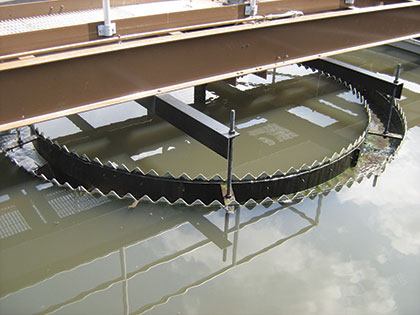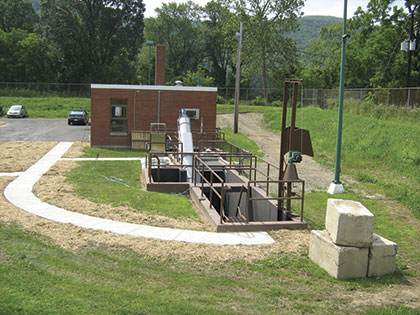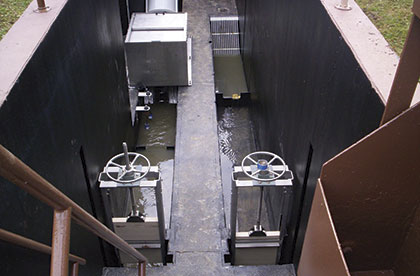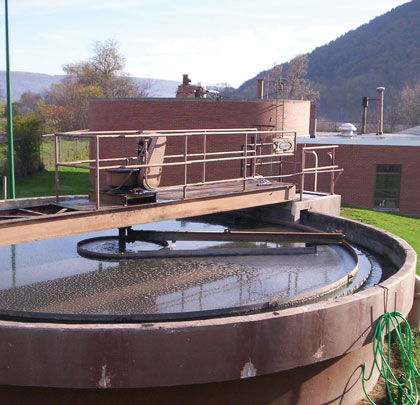Clarifier pre-construction at Addison; worn gearbox, cracked walls and a worn arm that would often stick.
Working alone in New York State, approximately 90 to 100 miles south of Rochester and Lake Ontario, plant operator Chuck Wright depends on the good performance and reliability of the equipment he diligently looks after near the Village of Addison.
With such a high level of responsibility, the beauty of well-engineered, low maintenance equipment cannot be underestimated—and following a $3.34 million upgrade to bring the thirty-four-year-old treatment facility up to code and meet New York State Department Environmental Conservation (DEC) requirements, Chuck is rightly proud of the clean and well maintained Addison Wastewater Treatment Plant.
CLEAN AND RUNNING SMOOTHLY
The Village of Addison had retained emerging national architecture, engineering, and survey firm Larson Design Group (LDG) for design and construction services, developing the project scope and funding applications for rehabilitation of the anaerobic digester unit, replacement of a wastewater pumping station, installation of a stand-by emergency generator and a mechanical bar screen.
Other improvements under LDG’s contract included the major task of replacing the clarifier internals, as well as raw wastewater pumps, trickling filter recirculation, and HVAC upgrades. Larson Design Group has also provided engineering services for the Village’s water supply and treatment system, local streets, and drainage problems within the Village.
Amid the substantial improvements, two pieces of equipment that have very steadily kept on doing their job at the (average) 220,000 gallons per day (420,000 permitted) plant are a Spiraflo Clarifier and a Raptor Fine Screen, which were both supplied by Lakeside Equipment Corporation in 2008.
“I do my best to keep everything clean and running smoothly,” says Chuck Wright at Addison, “but I have no problems at all with the clarifier or the screen. Apart from occasional oil changes and a few squirts of grease, these keep working very well”
He adds, “Compared to some pieces of equipment, Lakeside’s seals and bearings are of exceptional quality. Nothing gums up or clogs. The Raptor Fine Screen does a great job getting rid of the paper and heavier particles before they can get to the clarifier.”
RETROFITTED TO FIT THE NEED
The Lakeside Spiraflo Clarifier was retrofitted into the existing concrete structure to replace an old center-feed peripheral take-off clarifier that performed poorly due to short-circuiting. With the new peripheral-feed center take-off Spiraflo Clarifier, Chuck Wright certainly doesn’t have to worry about short-circuiting because its spiraling flow pattern flows around the baffle skirt and under the skirt to ensure maximum use of the entire tank volume (26-feet diameter—and shallow 8.5-feet depth).

New Lakeside Spiraflo Clarifier at Addison.

New Lakeside Raptor Screen at Addison.
This is in contrast to a typical center-feed clarifier flow pattern that is subject to the waterfall effect and sludge wall creep, which allows the influent to short-circuit directly to the effluent weirs, allowing solids carry over. The center-feed flow pattern flows counter-current (outward), compared to the sludge scraper that is moving solids inward to the sludge draw-off pit.
This short-circuiting prevents complete use of the tank volume for the settling process.
THE SPIRAFLO CLARIFIER: A CLOSER LOOK
Conversely, wastewater enters the Spiraflo Clarifier at the periphery of the tank and is directed along the narrow raceway formed by the baffle skirt and the outer wall. This flow pattern dissipates the wastewater’s hydraulic energy as it flows around the raceway and eventually spirals down under the skirt. Wastewater enters the main settling area from the full circumference of the skirt and slowly rises to pass over the centrally located effluent weirs. The inflow is prevented from flowing directly to the effluent weir by the specially designed race baffle skirt, which extends down to approximately two feet above the tank floor. The Spiraflo hydraulic flow pattern is in the same direction (inward) as the sludge collector is rotating and moving the solids (inward) to the sludge draw-off pit. The spiralling flow pattern makes use of total tank volume for more effective solids settling.
Twin Tiers Director of LDG’s Operations (Civil Division) Gregory M. Cummings, PE, comments, “Before the recent main upgrade, the previous clarifier was getting overloaded and had started exceeding recommended values, so we had to act then to keep the Addison plant in compliance.”
He adds, “We’d had previous experience with Lakeside and always found them good to work with. We also knew of the many advantages of the Spiraflo Clarifier, the Raptor Screen and their proven track record. Nine years later, this equipment certainly meets the ‘fit and forget’ description. There haven’t been any problems at all.”
SCREENINGS THROUGH THE PROCESS
As well as screening Addison’s wastewater, the Lakeside Raptor also washes, compacts, and transports the screenings. With a screen diameter of 26 to 71 inches and maximum flow capacities higher than 20 million gallons per day, liquid flows through the Raptor’s 3-plane screening basket, with solids efficiently trapped by the screen bars that form the circular basket. When liquid rises to a predetermined level, the rake begins to rotate, cleaning the screen bars. The rake’s teeth pass between the bars of the screen to remove captured materials. When the rake reaches the top of the screen, the captured material drops into the central screw conveyor. For complete cleaning, the rake reverses direction and passes through a hinged comb. The central screw conveyor then transports the material as it is washed, compacted, and dewatered on its way to the discharge chute. After discharge, dewatered screenings have a solids content exceeding 40 percent.

Looking into the new Lakeside Raptor Screen at Addison.
Screenings are initially washed as they are deposited in the collection trough. In the upper section of the transport tube, screenings are washed a second time. The macerating action of the screw breaks down large organic particles, which are then washed back into the flow stream. A spray wash system in the dewatering chamber removes any collected material to ensure free drainage of water, which is then removed in the compaction process.
SUPERIOR PERFORMANCE
LDG is currently working with the Village to address infiltration and inflow (I&I) issues into the wastewater collection system. During periods of wet weather, the flow through the wastewater system can sometimes triple, indicating that water is entering the system where it shouldn’t be. Work includes uncovering buried manholes, televising the entire collection system and rehabilitating portions of the system where I&I issues are identified to be at their worst.
Gregory M. Cummings adds, “At Larson Design Group we very much embrace innovation and welcome cutting-edge, new approaches within our practice areas, but the tried and tested design and cost-effectiveness of the Lakeside Spiraflo is hard to beat. There’s the superior performance, not to mention the savings that are made on construction and installation. The Raptor Screen is also very well designed and extremely durable, so we are happy with the knowledge that as the village of Addison’s trusted advisor, we are providing high quality long-lasting solutions for the wellbeing of the community.” ◆
Lakeside Equipment Corporation is an engineering and manufacturing company concentrating on helping to improve the quality of our water resources. Lakeside started in the Spring of 1928 to engineer, develop, and provide water purification systems to municipalities and companies throughout North America. For more information, visit www.lakeside-equipment.com.
____________________________________________
MODERN PUMPING TODAY, February 2018
Did you enjoy this article?
Subscribe to the FREE Digital Edition of Modern Pumping Today Magazine!
![]()


